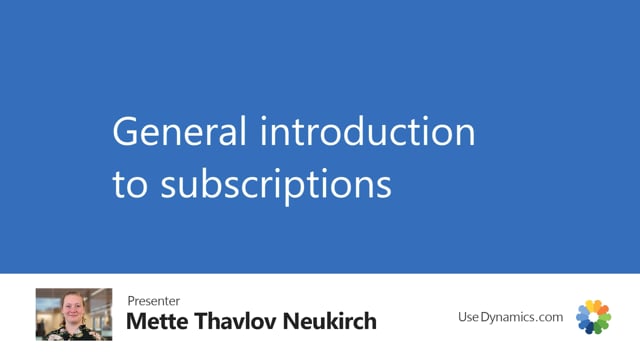
As you probably know, Subscription Management is an app that extends functionality in standard Business Central. So it’s an app that you install in your system in order to get the functions that I mentioned in these videos.
In the model here, I’ve marked all the standard elements that we’re using with blue and the additions by the app in orange. So as you can see, we add a list of subscriptions and then a little extra functionality in the create invoice function. Just so we can make subscription invoices. We still create a draft sales invoice that you can post to get a posted invoice and send to your customer. You don’t have to create a lot of extra setups. We use standard items, standard customers, deferral codes, etc.
The main thing that’s different is that you have the subscriptions as a separate list. Where you can of course handle the recurrence of the invoicing and everything that’s needed in order to control your subscription invoicing. In some of the other videos, I will go into more details. But essentially, you need to know that the subscriptions are based on the standard feature, blanket sales orders. We have just extended the functionality so you can focus on recurring invoicing instead of a normal blanket sales order. That focus on a sales agreement where the customer commits to a certain quantity. And then can make withdrawals on sales orders in a given period.
In subscription invoicing, we have a fixed invoicing interval. And of course, we can make adjustments to the number of items we’re selling or extra lines. But it’s a fixed interval of invoicing. Whereas the sales blanket orders is mainly used in demand planning. And the customer decides when they wish to make their withdrawals. As you can see here, the minimum required setup isn’t that much. You need to have the subscription setup and you will actually do that when you install the app and run the wizard. You need to have customers because you cannot create a subscription that isn’t linked to a customer. And then of course, you need to create your subscriptions. I also recommend to create items because you can inherit prices or dimensions and text from those. And you can create sales prices and discounts on those items. And then of course, deferral codes if you want to use the standard deferral function to defer your income. And finally, I’ve added dimensions because a lot of companies use that for reporting. And of course, you need to make sure you handle that on your subscriptions as well.
So just to sum up, by installing the Subscription Management app, you extend Business Central and you get a subscription invoice engine. And this way, you can easily do recurring subscription-based invoicing. And the most general use is for licenses or memberships, but it can be anything you need to invoice in a fixed recurring interval.
As I’ve shown, the app is quite simple and doesn’t require a lot of setup. So usually, our customers are able to do it themselves or with minimal consultant service. And that makes it cheaper, of course, to implement. You can handle different types of subscriptions and generate invoices per customer or per subscription or even per line. And you can invoice them per line, per resource. And you can invoice different types, so items or resources or GL accounts. There’s a bug action feature you can use to generate invoices across all subscriptions. You can actually generate all sales invoices using very few clicks. The text you write on the subscription will be generated as the invoice line text. So you’re able to customize what’s written on each subscription. And that is what will go on the invoice lines. Furthermore, you’re able to add a header text as the top line on your invoice lines, if you wish to write a comment to your customer.
You can create deferral plans, dimensions, discount, and income recognition per line. And they will be posted as individual lines in the GL.

